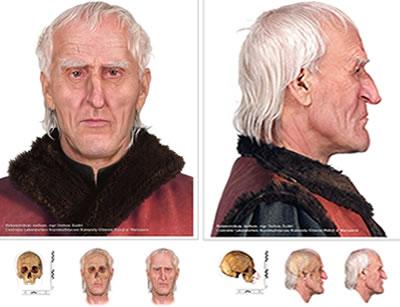Polish archaeologists think the skulls and bones they excavated last year in a Polish church are very probably the remains of Nicolaus Copernicus, the father of modern astronomy.
 The forensic team reconstructed this face from the remains - which looks a little like Copernicus. To see portraits of the astronomer, click here© Capt. Dariusz Zajdel / Central Forensic Laboratory of the Polish Police.
The forensic team reconstructed this face from the remains - which looks a little like Copernicus. To see portraits of the astronomer, click here© Capt. Dariusz Zajdel / Central Forensic Laboratory of the Polish Police.The excavating team sent the remains to forensic scientists in Warsaw without telling them who they suspected the skeleton belonged to. Last Thursday the Warsaw experts revealed their reconstruction of the person's face: a picture of an old man with a broken nose and a scar above the brow. These features match those seen in portraits of Copernicus from the 1500s.
To confirm their theory, archaeologists have mounted a search for the grave of Copernicus' maternal uncle, Lukas Watzenrode. Genetic comparison of the bones will reveal whether they belonged to uncle and nephew, the scientists hope.
The former Bishop of Ermland died in 1512 in the Polish city of Torun, Copernicus' birthplace, and is thought to be buried there or close by.
Hopeful find
"I'm 97% sure that what we have found must be Copernicus," says Jerzy Gassowski, an archaeologist at the Institute of Anthropology and Archaeology in Pultusk, who led the excavation. But only a DNA test will ultimately settle the case, he admits.
The search for Copernicus began two years ago; the Bishop of Frombork, a small town on Poland's Baltic coast where Copernicus had served as a member of the clergy, commissioned Gassowski to search the town's large gothic cathedral for the astronomer's grave.
As Gassowski's team had no written documents about Copernicus's burial, they began the excavations with little hope. But last year they discovered a heavily damaged skull and skeleton parts beneath one of the cathedral's 16 altars.
Brought to life
ADVERTISEMENT
Having the bones turned into a facial reconstruction was an important step in identifying the body. But the team admits that they didn't have much to compare the reconstruction to. When Copernicus died in 1543 at the age of 70 he was not a celebrity. So few paintings of him are available.
His famous book De Revolutionibus Orbium Coelestium (On the Revolutions of the Heavenly Spheres), in which he first proposed that the Earth revolves around the Sun, was published after his death. And astronomy was little more than a spare-time occupation for the clerical man whose name now stands as one of the most significant in the history of science.
